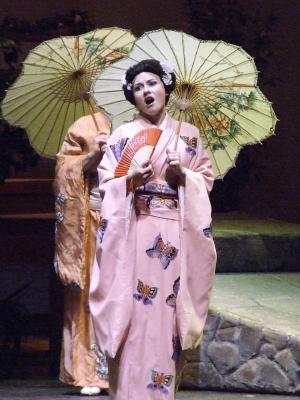|

Expansive Romanticism
'Madama Butterfly' from Long Island,
reviewed by MARIA NOCKIN
In 1877, a French naval officer who wrote novels under the pen name, Pierre Loti, published a story about a romance between a European man and a Japanese woman. Entitled Madame Chrysanthème, it aroused a great deal of interest in Asian customs, art and culture. In 1893, composer André Messager composed a then popular opera based on it and, five years later, John Luther Long wrote a romanticized version of the story in English from which David Belasco constructed a play that was seen in London after a successful New York run.
When Giacomo Puccini was in London to supervise the British première of Tosca, he saw the play and was so fascinated with the title character that he immediately asked Belasco to allow him to make it into an opera. When the rights had been secured, the composer asked Luigi Illica and Giuseppe Giacosa, the librettists with whom he had written Manon Lescaut, La bohème and Tosca to work on Madama Butterfly. Unfortunately, it was to be the last of their three-part collaborations because of the death of Giacosa in 1906.

Elena Razgylyaeva in the title role of 'Madama Butterfly' in Teatro Lirico D'Europa's production. Photo © 2006 Robin Grant
|
Japan so fascinated Puccini that he prevailed upon the wife of the Japanese ambassador in Rome to teach him about that country's music, art and customs. During 1902 and the first part of 1903, he worked on the new opera, but after fracturing his leg in an auto accident, he had to take some months to recover.
Continue >>
Copyright © 19 November 2006
Maria Nockin, Arizona USA

|

